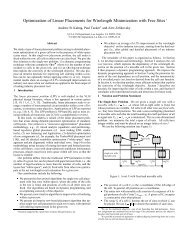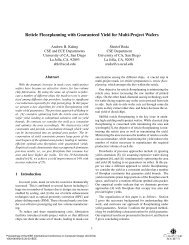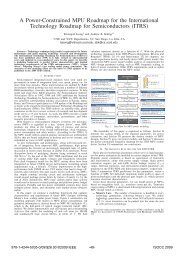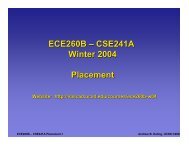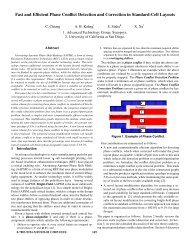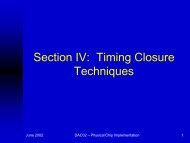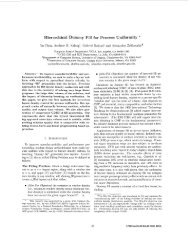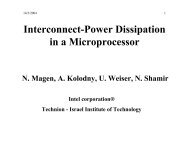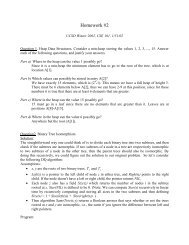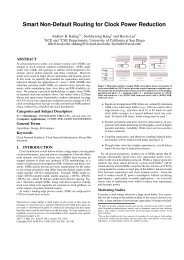Delay Analysis of VLSI Interconnections Using the Di usion Equation ...
Delay Analysis of VLSI Interconnections Using the Di usion Equation ...
Delay Analysis of VLSI Interconnections Using the Di usion Equation ...
- No tags were found...
You also want an ePaper? Increase the reach of your titles
YUMPU automatically turns print PDFs into web optimized ePapers that Google loves.
<strong>Delay</strong> <strong>Analysis</strong> <strong>of</strong> <strong>VLSI</strong> <strong>Interconnections</strong><strong>Using</strong> <strong>the</strong> <strong>Di</strong><strong>usion</strong> <strong>Equation</strong> Model Andrew B. Kahng and Sudhakar MudduUCLA Computer Science Department, Los Angeles, CA 90024-1596AbstractThe traditional analysis <strong>of</strong> signal delay in a transmissionline begins with a lossless LC representation,which yields a wave equation governing <strong>the</strong> system response;2-port parameters are typically derived and<strong>the</strong> solution is obtained in <strong>the</strong> transform domain. Inthis paper, we begin with a distributed RC line model<strong>of</strong> <strong>the</strong> interconnect and analytically solve <strong>the</strong> resultingdi<strong>usion</strong> equation for <strong>the</strong> voltage response. A newclosed form expression for voltage response is obtainedby incorporating appropriate boundary conditions forinterconnect delay analysis. Calculations <strong>of</strong> 50% and90% delay times for various cases <strong>of</strong> interest (e.g.,open-ended RC line) give substantially dierent estimatesfrom those commonly cited in <strong>the</strong> literature,thus suggesting revised delay estimation methodologiesand intuitions for <strong>the</strong> design <strong>of</strong> <strong>VLSI</strong> interconnects.The discussion fur<strong>the</strong>rmore provides a unifyingtreatment <strong>of</strong> <strong>the</strong> past three decades <strong>of</strong> RC interconnectdelay analyses.1 Overview<strong>Delay</strong> analysis <strong>of</strong> <strong>VLSI</strong> interconnections is a key elementin timing verication, gate-level simulation andperformance-driven layout design. The standard approachtomodelinginterconnect delay has been basedon a simple lossless LC model which considers onlyinductances (L) and capacitances (C). For this losslessmodel, <strong>the</strong> relationship between v and i gives riseto a second-order partial dierential equation <strong>of</strong> <strong>the</strong>form [9]:@ 2 v@x 2= LC @2 v@t 2 (1)and <strong>the</strong> solution to this wave equation is <strong>of</strong> <strong>the</strong> formv(x) =A 1 e x + A 2 e ,x (2) This work was supported byNSFYoung InvestigatorAwardMIP-9257982. Part <strong>of</strong> <strong>the</strong> work <strong>of</strong> S. Muddu was done during<strong>the</strong> course <strong>of</strong> a Summer 1993 internship at Intel Corporation.where propagation constant p |! lc (l and c are<strong>the</strong> inductance and capacitance per unit length, and! is <strong>the</strong> wave frequency).One easily extends this model to lossy (RLC) interconnectsby incorporating a series resistance. Thesame equations obtained for <strong>the</strong> lossless model canbe used, with Z L = R + |!L = |![ R + L]; i.e.,|!Z L = |!L 0 where L 0 = R + L is <strong>the</strong> new inductance|!value. Similarly, one may incorporate a conductanceG via Z C = G + |!C = |![ G + |! C]; i.e., Z C = |!C 0where C 0 = G + C is <strong>the</strong> new capacitance. The same|!solution derived for <strong>the</strong> lossless model can incorporate<strong>the</strong> new L 0 and C 0 values to capture <strong>the</strong> attenuationfactor in lossy lines.<strong>Using</strong> <strong>the</strong> solution (2) to <strong>the</strong> wave equation, and<strong>the</strong> characteristic impedance <strong>of</strong> <strong>the</strong> line, one may treat<strong>the</strong> interconnect line as a 2-port and obtain equationsfor voltage and current at <strong>the</strong> terminal side <strong>of</strong> <strong>the</strong> 2-port in terms <strong>of</strong> voltage and current at <strong>the</strong> source side.This yields <strong>the</strong> 2-port matrix parameters, e.g., ABCDparameters. To obtain <strong>the</strong> transient time-domain response<strong>of</strong> an interconnect line, <strong>the</strong> standard approachhas been to calculate <strong>the</strong> response in <strong>the</strong> transform domainusing 2-port parameters, and <strong>the</strong>n apply inversetransforms to obtain <strong>the</strong> response in <strong>the</strong> time domain.We call this <strong>the</strong> LC analysis, or wave equation, approach.Since it may be complicated to apply <strong>the</strong> inversetransforms, various approximations are typicallymade which simplify <strong>the</strong> resulting expressions for <strong>the</strong>time-domain response.For <strong>the</strong> well-studied case <strong>of</strong> an RC transmissionline, <strong>the</strong> traditional LC analysis is extended to anRLC analysis after which L is set to zero. But bycontrast, if we initially model <strong>the</strong> interconnect as apure distributed RC line, we obtain a di<strong>usion</strong> equation(or heat equation) from which <strong>the</strong> solution for<strong>the</strong> transient response, depending on boundary conditions,can be calculated analytically. This RC-baseddelay analysis approach, and its implications, are <strong>the</strong>subject <strong>of</strong> <strong>the</strong> present paper.Our motivation for adopting <strong>the</strong> RC-based delayanalysis is as follows. For previous generation interconnects,such as for PCB, <strong>the</strong> resistance per unitlength (r) is considerably smaller than <strong>the</strong> inductiveimpedance (!l), i.e., r !l, so that <strong>the</strong> conventionalLC-based analysis seems reasonable. However, withsmall feature sizes <strong>of</strong> thin-lm and IC interconnects,we now nd that r !l up to frequencies <strong>of</strong> O(1)
v 2 (t) V 04 p RC[1 , e ,2:467 tRC ] (t RC) (9)Sakurai [20] uses a similar 2-port model and obtains<strong>the</strong> voltage response asv 2 (t) =V 0 (1 , 1:273e ,2:467 tRC+0:424e,22:206 tRC )(10)These works, particularly [25], have had great inuenceon <strong>the</strong> literature. For example, Saraswat and Mohammadi[21] use <strong>the</strong> results <strong>of</strong> [15, 25] to obtain <strong>the</strong>irrise time estimates. Bakoglu and Meindl [4] also citeWilnai's derivation, and write: \Under step-voltageexcitation, <strong>the</strong> times (T ) required for <strong>the</strong> output voltage<strong>of</strong> distributed and lumped RC networks to risefrom 0 to 90 percent <strong>of</strong> <strong>the</strong>ir nal values are 1:0RCand 2:3RC, respectively." ([4], p. 904). The authors<strong>of</strong> [4] go on to state a \very good approximation fordelay":T = 1:0R int C int +2:3(R tr C int + R tr C L + R int C L ) (2:3R tr + R int )C int (11)(R int and C int are respectively <strong>the</strong> interconnect resistanceand capacitance, R tr is <strong>the</strong> output resistance <strong>of</strong><strong>the</strong> driving transistor and C L is <strong>the</strong> load capacitance).This last expression (11) has been frequently invokedin <strong>the</strong> literature (see [1], [22] or<strong>the</strong>book[3]).Interestingly, <strong>the</strong> voltage response for a step inputusing <strong>the</strong> 2-port model has been rederived manytimesin <strong>the</strong> literature. For example, Antinone and Brown[2] express cosh( p sRC) as an innite product seriesand <strong>the</strong>n consider only <strong>the</strong> rst three terms <strong>of</strong> <strong>the</strong>product expansion. This is not a good approximationbecause <strong>the</strong> coecients <strong>of</strong> s and s 2 are not exact, anddepend heavily on <strong>the</strong> number <strong>of</strong> terms used in <strong>the</strong>product expansion. Mey [17] noted <strong>the</strong> crudeness <strong>of</strong>this approximation and proposed an innite partialfraction expansion, thus obtaining <strong>the</strong> same solutionas Sakurai. Ghausi and Kelly [11] are yet ano<strong>the</strong>rgroup who earlier published <strong>the</strong> identical analysis.The common feature <strong>of</strong> all <strong>the</strong>se works is that <strong>the</strong>yuse <strong>the</strong> 2-port transfer matrix <strong>of</strong> <strong>the</strong> distributed RCline to obtain <strong>the</strong>ir respective time-domain estimates<strong>of</strong> <strong>the</strong> transient response. The 2-port parameters for<strong>the</strong> distributed RC line are obtained from <strong>the</strong> solution<strong>of</strong> <strong>the</strong> wave equation (2) for v and i (see, e.g., [9]). Butas we discuss in Section 3 below, voltage or current ina pure distributed RC line obeys a di<strong>usion</strong> equation.2.2.2 A Previous Time-Domain <strong>Analysis</strong>Finally, a solution which uses time-domain analysis isthat <strong>of</strong> Kaufman and Garrett [15], who formulate adistributed RC model for interconnect and derive adi<strong>usion</strong> equation for voltage on <strong>the</strong> line. However,to obtain <strong>the</strong> transient response to a step input, [15]makes <strong>the</strong> simplifying assumption v(x; t) =f(x)g(t),namely, separability <strong>of</strong><strong>the</strong>voltage response into separatefunctions <strong>of</strong> time and position; this leads to acomplicated and special-case solutionv 2 (t) =1, 4 1Xn=0(,1) n2n +1 e,((2n+1)=2)2 t=RC(12)Considering only <strong>the</strong> rst few terms <strong>of</strong> <strong>the</strong> series yieldsv 2 (t) (1 , 1:273e ,2:467 tRC +0:424e,22:206 tRC )(13)This expression is dierent from that <strong>of</strong> Wilnai orPeirson, but is identical 1 to that given by Sakurai(<strong>Equation</strong> 10). The book <strong>of</strong> Ghausi and Kelly [11]gives an analysis using <strong>the</strong> same separability assumption.These previous delay approximations are summarizedin Table 1 below.3 The <strong>Di</strong><strong>usion</strong> <strong>Equation</strong> <strong>Analysis</strong>3.1 Obtaining <strong>the</strong> <strong>Di</strong><strong>usion</strong> <strong>Equation</strong>from <strong>the</strong> <strong>Di</strong>stributed RC Modeli(x,t) i(x+dx,t) r(x) dxv(x,t)xc(x) dxv(x+dx,t)x+dxc(x) dxr(x) dxFigure 2: Lumped approximation for x in adistributed RC line.The di<strong>usion</strong> equation for voltage in a distributedRC line can be derived from rst principles as follows(see [15]). Consider a lumped approximation for x<strong>of</strong> <strong>the</strong> line, as shown in Figure 2. By applying simplenodal equations at <strong>the</strong> nodes x and x +x, we obtain@v(x; t)i(x; t) = c(x)x + i(x +x; t)@tv(x; t) = r(x)xi(x +x; t)+v(x +x;t)where r(x) and c(x) are resistance and capacitanceper unit length. As x ! 0, and for constant r(x)and c(x), <strong>the</strong> above equations reduce to <strong>the</strong> di<strong>usion</strong>equationrc @v@t = @2 v@x : (14)2The solution <strong>of</strong> <strong>Equation</strong> (14) can be obtained byrestricting it to <strong>the</strong> set <strong>of</strong> solutions <strong>of</strong> <strong>the</strong> form v( x p t)p rcusing <strong>the</strong> substitution variable = x [14]. This is2t<strong>the</strong> appropriate substitution for a parabolic equation.We obtainv() =C 1Z 0e , 22 d + C 2 (15)One can also obtain this solution directly from <strong>the</strong>heat kernel for <strong>the</strong> di<strong>usion</strong> equation [7]. This shouldbe contrasted with <strong>the</strong> solution <strong>of</strong> [15], which mustassume <strong>the</strong> separable form for v(x; t). Of course, <strong>the</strong>solution we obtain will be highly dependent on <strong>the</strong>boundary conditions that apply; in particular, we areinterested in <strong>the</strong> well-studied case <strong>of</strong> <strong>the</strong> open-endeddistributed RC line.1In <strong>the</strong> taxonomythatwe present below, <strong>the</strong> result <strong>of</strong> Kaufmanand Garrett is characterized as \approximate" because<strong>the</strong>ir method must assume <strong>the</strong> special form <strong>of</strong> <strong>the</strong> di<strong>usion</strong> equationsolution. On <strong>the</strong> o<strong>the</strong>r hand, Sakurai's result is \exact"with respect to <strong>the</strong> distributed RC 2-port analysis.
Method Accuracy/ Time-DomainRegimeVoltage ResponseSimple Approximate V 0 (1 , e , RC t)Lumped ModelWilnai's Small t 2V 0 (1 , erf(2-port ModelLarge tMattes'sExactqRC4t ))V 0 (1 , 1:366e ,2:5359 tRC +0:366e ,9:4641 tRC )P 2-port Model 1q2V 0 n=1 (,1)n,1 1 , erf( 2n,12qPeirson's Small t 2V 0 (1 , erf(RC4t ))2-port Model Large t V 0 1:273 p RC(1 , e ,2:467 tSakurai'sExact but2-port Model approximated V 0 (1 , 1:273e ,2:467 RCtto three termsKaufman's Heuristic derivation<strong>Di</strong><strong>usion</strong> but approximated V 0 (1 , 1:273e ,2:467 RCt<strong>Equation</strong> Model to three termsAntinone/Brown's2-port modelApproximateV 0 (1 , 1:172e ,2:467 tRC+0:195e ,22:206 tRCOur <strong>Di</strong><strong>usion</strong> Exact V 0 (1 , erf(<strong>Equation</strong> ModelRC )RC) t+0:424e ,22:206 tRC )+0:424e,22:206 tRC )qRC4t )), 0:023e ,61:685 tRC )Table 1: Voltage response <strong>of</strong> an open-ended distributed RC line under a step input excitation <strong>of</strong>magnitude V 0 . () Response calculated from <strong>the</strong> transfer function in [PB69].3.2 Boundary ConditionsFor <strong>the</strong> distributed RC line, we derive <strong>the</strong> twoboundary conditions necessary to solve <strong>Equation</strong> (15)as follows.Boundary Condition 1: At t = 0, <strong>the</strong> line is quietand v(x; t) = 0 for all x, i.e.,Therefore,C 1r2 + C 2 =0:C 2 = ,C 1r2(16)Note that this boundary condition applies to everynew wave that is born due to reection.Boundary Condition 2: The second boundarycondition is obtained from <strong>the</strong> structure <strong>of</strong> <strong>the</strong> inputapplied at <strong>the</strong> front end <strong>of</strong> <strong>the</strong> transmission line(x = 0) and in terms <strong>of</strong> <strong>the</strong> rise-time value, t rise . Noticethat <strong>the</strong> voltage at x = 0 depends on <strong>the</strong> sourceimpedance, Z S , and <strong>the</strong> characteristic impedance <strong>of</strong><strong>the</strong> line, Z 0 , since this structure acts as a voltage divider.Therefore <strong>the</strong> voltage at <strong>the</strong> beginning <strong>of</strong> <strong>the</strong>line, i.e at x = 0, in <strong>the</strong> transform domain is given byV 1 (s) =(Z in) V 0Z in + Z S s(17)where Z in is <strong>the</strong> input impedance looking into <strong>the</strong> interconnectline.At a given rise-time (t = t rise ), <strong>the</strong> voltageV 1 (0;t rise ) at <strong>the</strong> front end <strong>of</strong> <strong>the</strong> transmission line canbe obtained from <strong>the</strong> time domain representation <strong>of</strong><strong>Equation</strong> (17). Let rise V 0 be this voltage at <strong>the</strong> risetime,i.e., V 1 (0;t rise )= rise V 0 , where 0 < rise 1.Substituting into <strong>Equation</strong> (15) and evaluating atx = , with tending to 0, we obtain rise V 0 = C 1Z p rc2t rise0e (, 2 2 ) d + C 2 (18)3.3 Solution <strong>of</strong> <strong>the</strong> <strong>Di</strong><strong>usion</strong> <strong>Equation</strong>We use (16) and (18) to solve forC 1 and C 2 :Z prcr2t rise rise V 0 = C 1 e (, x2 2 ) dx , C 12yieldsfrom whichC 1 = rise V 0 01[ R p rc2t rise0e , x2 2 dx , p 2 ]V () = rise V 0 [1 , erf( p2)] (19)
1where =[1,erf( 2p : rct)] riseTo achieve <strong>the</strong> case <strong>of</strong> an ideal step input, <strong>the</strong>boundary condition at x = 0 should be evaluatedfor t rise tending to zero and rise tending to 1, i.e.,we let t rise = " with " ! 0. Then, <strong>the</strong> error functionargument in <strong>the</strong> expression for will tend tozero, since and " both tend to zero with <strong>the</strong> numerator<strong>of</strong> higher degree than <strong>the</strong> denominator, i.e.,lim rc!0;"!0 2p=0: Therefore, = 1 and <strong>the</strong> di<strong>usion</strong>equation solution reduces"toV () =V 0 [1 , erf( p2)]: (20)modied to consider <strong>the</strong> new delay values obtainedabove. We emphasize that our result does not implythat <strong>the</strong> previous LC-based approach is wrong.Ra<strong>the</strong>r, our work simply shows that solving <strong>the</strong> di<strong>usion</strong>equation for RC interconnects yields a very differentperspective ondelay calculations. A careful experimentalinvestigation is needed to determine <strong>the</strong>respective regimes for which <strong>the</strong>se models are valid.Voltage1.11Open-Ended <strong>Di</strong>stributed RC Line <strong>Delay</strong>Peirson’s ModelWilnai’s and Kaufman’s ModelsObserve that <strong>the</strong> same result is obtained when <strong>the</strong>input corresponds to an ideal source, i.e., Z S = 0,V 1 (s) = V0 ,withvoltage at x = 0 constant for all tsand equal to V 0 . Inthiscase,V (0;t)=V 0 u(t) andusing this condition in <strong>Equation</strong> (15) yields0.90.80.70.60.5Lumped Model<strong>Di</strong>ff<strong>usion</strong> <strong>Equation</strong> ModelV 0 = C 1Z =xp rc2t =0from which C 2 = V 0 and0e , x22 dx + C 2V () =V 0 [1 , erf( p2)]: (21)This result is <strong>the</strong> same as <strong>Equation</strong> (20), as we expect.The same <strong>Equation</strong> (20) can also be obtained byusing <strong>the</strong> Boundary Condition 2 and ano<strong>the</strong>r boundarycondition which captures <strong>the</strong> open end <strong>of</strong> <strong>the</strong> line[14]. We believe that <strong>the</strong> voltage on <strong>the</strong> line will betterobey <strong>Equation</strong> (20) near <strong>the</strong> source than near <strong>the</strong> load;ongoing experimental eorts are aimed at validatingthis belief. A comment is in order: <strong>the</strong> two boundaryconditions we use are discontinuous (at x =0,t = 0),but this discontinuity smooths immediately and <strong>the</strong>solution is still valid.3.4 Threshold <strong>Delay</strong> Calculations <strong>Using</strong><strong>Di</strong><strong>usion</strong> <strong>Equation</strong> ModelWe now proceed with delay calculations for a casethat has been <strong>of</strong> interest throughout <strong>the</strong> literature,namely, <strong>the</strong> open-ended distributed RC line with anideal source. Recall that with an ideal step input, = 1 in (19), <strong>the</strong> solution reduces to that given in(20). The equation for <strong>the</strong> voltage response for anideal source is obtained in <strong>Equation</strong> (21). <strong>Using</strong> errorfunction tables, we easily calculate <strong>the</strong> time for a signalapplied at <strong>the</strong> input <strong>of</strong> an interconnect to reach agiven threshold voltage at distance x (on <strong>the</strong> line) from<strong>the</strong> input terminal. For example, our di<strong>usion</strong> equationsolution implies 2:18R x C x for 63% delay time.One can see that <strong>the</strong> delay times for <strong>the</strong> di<strong>usion</strong>equation model are substantially dierent from thosecommonly employed in <strong>the</strong> literature, i.e., <strong>the</strong> Elmoredelay (for a single RC line) <strong>of</strong> t x (63%) = RxCx2. Thisdierence would certainly aect standard delay estimates:for example, minimum clock skew routing resultswhich use lumped models will be aected when0.40.30.20.1t/RC00 1 2 3 4 5Figure 3: Unit step response for lumped RCmodel and various distributed RC models. Notethat Wilnai's and Kaufman's models are notidentical: Kaufman's ( Sakurai's) model givesa non-monotone response. Also note that <strong>the</strong> responsein Peirson et al.'s model is dependent on<strong>the</strong> RC constant; we have plotted <strong>the</strong> responsefor RC =1.4 Extensions <strong>of</strong> <strong>the</strong> <strong>Di</strong><strong>usion</strong> <strong>Equation</strong><strong>Analysis</strong>We close our development by extending <strong>the</strong> basicresult <strong>of</strong> <strong>Equation</strong> (20) in two ways: (i) introducingan analysis <strong>of</strong> reections, and (ii) incorporating nonzerotime <strong>of</strong> ight into <strong>the</strong> analysis.4.1 <strong>Analysis</strong> <strong>of</strong> ReectionsRecall that <strong>the</strong> total voltage on <strong>the</strong> line is given by<strong>the</strong> summation <strong>of</strong> <strong>the</strong> incident wave and all reectedwave components. The reections are due to discontinuities,e.g., at <strong>the</strong> source (S) and load (L). In o<strong>the</strong>rwords,~V Tot () =V I ()+1Xi=1~V Ri () (22)where V I () voltage corresponding to <strong>the</strong> incidentwave and ~ V Ri () voltage corresponding to <strong>the</strong> i threected wave. Neglecting <strong>the</strong> time <strong>of</strong> ight, at anytime <strong>the</strong> expressions for any individual ~ V Ri () will be<strong>of</strong> <strong>the</strong> same form as <strong>the</strong> incident voltage expressionV I (), but with dierent initial voltage. The solutionfor V I () isgiven by (19) in general, and by (20) for
an ideal step input. We use <strong>the</strong>se expressions to calculate<strong>the</strong> total voltage on <strong>the</strong> line for general sourceand load impedances. Note that since Z S and Z L arein general complex, we must treat V Tot () and V Ri ()as phasors V ~ Tot () and V ~ Ri () which are functions <strong>of</strong>time (t), distance (x) and frequency (!). If V ~ Tot ()is a phasor, <strong>the</strong> delay calculations should compare <strong>the</strong>magnitude <strong>of</strong> total voltage (i.e., absolute value <strong>of</strong> <strong>the</strong>phasor, j V ~ Tot ()j) with <strong>the</strong> threshold value <strong>of</strong> interest.Luckily, <strong>the</strong> assumptions in typical cases <strong>of</strong> interest,while in some ways unrealistic, make <strong>the</strong> analysistractable and aord lower bounds for <strong>the</strong> delay estimates.In <strong>the</strong> general case, <strong>the</strong> reection coecients are, S = ZS,Z0Z S+Z 0<strong>the</strong> load yieldsand , L = ZL,Z0Z L+Z 0. The rst reection at~V R1 () =, L V I ();<strong>the</strong> second reection at <strong>the</strong> source yields~V R2 () =, S , L V I ();and in general <strong>the</strong> i th reection gives ~ V Ri () =2, i , 2iL S V I() for i even, with <strong>the</strong> case <strong>of</strong> i odd beinganalogous. <strong>Using</strong>~V Tot () = V I ()+1Xi=1~V Ri ()= V I ()[1 + , L +, S , L + :::+, i 2L , i 2S + :::]and separating odd and even terms <strong>of</strong> <strong>the</strong> summation,we obtain <strong>the</strong> general solution~V Tot () = rise ( 1+, L1 , , L , S)V 0 [1 , erf( p2)]The form <strong>of</strong> this expression, i.e., as a sum <strong>of</strong> errorfunction terms, is quite intuitive.Wemay again consider examples <strong>of</strong> source and loadimpedances which have received particular attentionthroughout <strong>the</strong> literature. 2Case 1: Finite-length, open-ended RC transmissionline with ideal source.With Z L = 1 (i.e., , L = 1), an ideal source(Z S =0,, S = ,1 and rise = 1) implies that all<strong>of</strong> <strong>the</strong> input voltage P appears at x = 0. Recalling that1~V Tot () =V I () + V ~ i=1 Ri (); we see that with re-ection coecients equal to +1 or ,1, all reectionswill cancel. Thus, <strong>the</strong> summation term in <strong>the</strong> equationdisappears and we obtain <strong>the</strong> same result as in<strong>Equation</strong> (21):~V Tot () = V I () =V 0 [1 , erf( p2)]2 Note that , L and , S will always have an implicit frequencydependence, and <strong>the</strong>refore ~ j V Tot ()j will also depend on <strong>the</strong>frequency.Case 2: Finite-length, open-ended RC transmissionline with perfectly matched source.With Z L = 1 (i.e., , L = 1) and source impedanceZ S = Z 0 (i.e., , S = 0), <strong>the</strong>re is only <strong>the</strong> single (initial)reection at <strong>the</strong> load. Thus,~V Tot () = V I ()+ ~ V R1 ()= 2[ rise V 0 (1 , erf( p2))]In practice, <strong>the</strong> open-ended approximation <strong>of</strong> an interconnectis <strong>of</strong>ten used since <strong>the</strong> input impedance <strong>of</strong>MOS devices is typically high compared to <strong>the</strong> characteristicimpedance <strong>of</strong> <strong>the</strong> line.4.2 Non-Zero Time <strong>of</strong> FlightLast, we note that <strong>the</strong> derivation <strong>of</strong> <strong>Equation</strong> (22)neglected <strong>the</strong> time <strong>of</strong> ight, T fl , and used identical expressionsfor incident and reected waves. For a maximumon-chip interconnect <strong>of</strong> length approximately1cm, <strong>the</strong> time <strong>of</strong> ight will be around 0:1ns [6]. However,<strong>the</strong> length <strong>of</strong> a typical single interconnect segmentwill be much smaller (on <strong>the</strong> order <strong>of</strong> 0:01cm)and T fl will be on <strong>the</strong> order <strong>of</strong> picoseconds. Since delaysfor typical operating frequencies <strong>of</strong> O(1) GHz are<strong>of</strong> <strong>the</strong> order <strong>of</strong> 0:1ns [8], one may reasonably neglectT fl in delay calculations, as has usually <strong>the</strong> case in <strong>the</strong>literature. Never<strong>the</strong>less, T fl becomes signicant withshorter rise or delay times, or with longer interconnects(e.g., for large die or MCM substrates). Here,we show that our analysis can extend to non-zero T fl .The key observation is that taking T fl into accountwill only increase our delay estimates, and <strong>the</strong>se estimatesare already larger than those in <strong>the</strong> literature.To account for a non-zero time <strong>of</strong> ight, we simplyrecord an additional displacement <strong>of</strong>T fl for each successivereection. The total voltage on <strong>the</strong> line after<strong>the</strong> i th reection is~V Tot (x; t) =V I (xrrc1X2t )+i=1~V Ri (xr rc2(t , iT fl ) )For example, if we consider non-zero T fl in Case 2<strong>of</strong> <strong>the</strong> previous subsection, <strong>the</strong> 90% delay time for aline <strong>of</strong> length h is obtained as follows.rrcr rcV I (h2t )+~ V R1 (h2(t , T fl ) )=0:9V 0which impliesrerf( h rc)+erf( h 2 t h 2rrct h , T fl) 1:1As expected, non-zero T fl will increase <strong>the</strong> 90% delaytime. The Case 2 analysis provides an upperbound on <strong>the</strong> voltage response, so <strong>the</strong> actual delaytime is lower-bounded by this equation. One couldsolve <strong>the</strong> equation through an iterative process, startingfromavaluethat is computed assuming T fl =0.For o<strong>the</strong>r cases, e.g., Case 1 above, T fl > 0 does notaect <strong>the</strong> previous analysis since <strong>the</strong>re are no reections.
5 SummaryA survey <strong>of</strong> three decades <strong>of</strong> interconnect delayanalyses reveals that <strong>the</strong> analysis <strong>of</strong> signal delay ina transmission line is traditionally performed startingwith a lossless LC representation and a wave equationfor <strong>the</strong> system response; <strong>the</strong> solution is obtainedin <strong>the</strong> transform domain via 2-port parameters. Inthis paper, we begin with a distributed RC line model<strong>of</strong> <strong>the</strong> interconnect, which yields a di<strong>usion</strong> equationfor <strong>the</strong> voltage response. We have given a new analyticsolution <strong>of</strong> this equation incorporating appropriateboundary conditions, and have obtained estimatesfor 50% and 90% delay times at arbitrary locations on<strong>the</strong> interconnect line that dier substantially from <strong>the</strong>delay estimates currently employed in <strong>the</strong> literature.Beyond its many implications for revised delayestimationmethodologies (e.g., for performance-driven routingtree construction, minimum-skew clock distribution,or buer placement), our time-domain solutionalso yields new intuitions regarding design objectivesfor <strong>VLSI</strong> interconnects. Our approach also handles<strong>the</strong> case <strong>of</strong> non-zero T fl .Our result does not imply that <strong>the</strong> previous LCbasedapproach is wrong, but ra<strong>the</strong>r shows that solving<strong>the</strong> di<strong>usion</strong> equation for RC interconnects canprovide a totally new perspective on delay calculations.Thus, we are also pursuing <strong>the</strong> central challenge<strong>of</strong> experimentally validating both our new model andprevious delay modelsinvarious technology regimes.AcknowledgmentsWe thank Pr<strong>of</strong>essor Ernest S. Kuh <strong>of</strong> UC Berkeley,Dr. Heinz Mattes <strong>of</strong> Siemens, and Pr<strong>of</strong>essor WayneWei-Ming Dai and Mr. Haifang Liao <strong>of</strong> UC Santa Cruzfor many helpful discussions and comprehensive commentson two early drafts <strong>of</strong> this work. Subsequentdiscussions with Pr<strong>of</strong>. Russell Caisch <strong>of</strong> UCLA andDr. Steven Altschuler <strong>of</strong> Micros<strong>of</strong>t Corp. have alsobeen very helpful. Part <strong>of</strong> this work was performedduring a sabbatical visit to UC Berkeley; <strong>the</strong> hospitality<strong>of</strong> Pr<strong>of</strong>essor Ernest S. Kuh and his research groupis gratefully acknowledged.References[1] M. Afghahi and C. Svensson, \Performance <strong>of</strong> Synchronousand Asynchronous Schemes for <strong>VLSI</strong> Systems", IEEETrans. on Computers, July 1992, pp. 858-872.[2] R. J. Antinone and G. W. Brown, \The Modeling <strong>of</strong> ResistiveInterconnectsfor Integrated Circuits", IEEE J. Solid-State Circuits 18, April. 1983, pp. 200-203.[3] H. B. Bakoglu, Circuits, <strong>Interconnections</strong> and Packagingfor <strong>VLSI</strong>, Addison Wesley, 1990.[4] H. B. Bakoglu and J. D. Meindl, \Optimal InterconnectionCircuits for <strong>VLSI</strong>", IEEE Trans. on Electron Devices, May1985, pp. 903-909.[5] J. Crank, The Ma<strong>the</strong>matics <strong>of</strong> <strong>Di</strong><strong>usion</strong>, 2nd ed., Oxford,Clarendon Press, 1975, pp 11-17.[6] W. M. Dai, \Performance Driven Layout for Thin-FilmMultichip Modules", Intl. J. <strong>of</strong> High Speed Electronics,1991, pp. 287-317.[7] E. B. Davies, Heat Kernels and Spectral Theory, CambridgeUniv. Press, 1989.[8] A. Deutsch, G. V. Kopcsay, V. A. Ranieri, J. K. Cataldo, etal., \High Speed Signal Propagation on Lossy TransmissionLines", IBM J. Res. Dev. 34 (1990), pp. 601-615.[9] L. N. Dworsky, Modern Transmission Line Theory andApplications, Wiley, 1979.[10] W. C. Elmore, \The Transient Response<strong>of</strong>DampedLinearNetworks with Particular Regard to Wideband Ampli-ers", J. App. Physics 19, Jan. 1948, pp. 55-63.[11] M. S. Ghausi and J. J. Kelly, Introduction to <strong>Di</strong>stributed-Parameter Networks: With Application to Integrated Circuits,Holt, Rinehart and Winston, 1968.[12] M. Healey, Tables <strong>of</strong> Laplace, Heaviside, Fourier, and ZTransforms, W. & R. Chambers Ltd., 1967.[13] C. C. Huang and L. L. Wu, \Signal Degradation ThroughModule Pins in <strong>VLSI</strong> Packaging", IBM J. Res. and Dev.31(4), July 1987, pp. 489-498.[14] A. B. Kahng and S. Muddu, \<strong>Analysis</strong> <strong>of</strong> <strong>VLSI</strong> <strong>Interconnections</strong>Based on <strong>the</strong> <strong>Di</strong><strong>usion</strong> <strong>Equation</strong> Model", UCLACS Dept. TR-940011, 1994.[15] W. M. Kaufman and S. J. Garrett, \Tapered <strong>Di</strong>stributedFilters", IRE Trans. on Circuit Theory, Dec. 1962, pp.329-336.[16] H. L. Mattes, \Behavior <strong>of</strong> a Single Transmission LineStimulated With a Step Function", manuscript, Aug. 1993.[17] D. D. Mey, \A Comment on `The Modeling <strong>of</strong> ResistiveInterconnects for Integrated Circuits' ", IEEE J. Solid-State Circuits, Aug. 1984, pp. 542-543.[18] R. C. Peirson and E. C. Bertnolli, \Time-Domain <strong>Analysis</strong>and Measurement Techniques for <strong>Di</strong>stributed RCStructures. II. Impulse MeasurementTechniques", J. App.Physics, June 1990, pp. 118-122.[19] J. Rubinstein, P. Peneld and M. A. Horowitz, \Signal<strong>Delay</strong> inRCTree Networks", IEEE Trans. on CAD, July1983, pp. 202-211.[20] T. Sakurai, \Approximation <strong>of</strong> Wiring <strong>Delay</strong> inMOSFETLSI", IEEE J. Solid-State Circuits, Aug. 1983, pp. 418-426.[21] K. C. Saraswat and F. Mohammadi, \Eect <strong>of</strong> Scaling <strong>of</strong><strong>Interconnections</strong> on <strong>the</strong> Time <strong>Delay</strong> <strong>of</strong> <strong>VLSI</strong> Circuits",IEEE J. Solid State Circuits SC-17(2), April 1982, pp.275-280.[22] M. B. Small and D, J. Pearson, \On-chip Wiring for <strong>VLSI</strong>:Status and <strong>Di</strong>rections", IBM J. Res. and Dev. 34(6), Nov.1990, pp. 858-867.[23] R. S. Tsay, \Exact Zero Skew", Proc. IEEE Intl. Conf. onComputer-Aided Design, 1991, pp. 336-339.[24] L. P.P.P. van Ginneken, \Buer Placement in <strong>Di</strong>stributedRC-Tree Networks for Minimal Elmore <strong>Delay</strong>", Proc. IEEEIntl. Symp. on Circuits and Systems, 1990, pp. 865-868.[25] A. Wilnai, \Open-Ended RC Line Model Predicts MOS-FET IC Response", EDN, Dec. 15, 1971, pp. 53-54.




